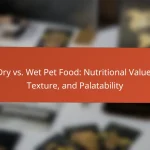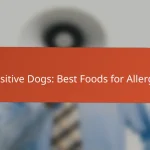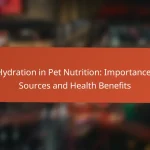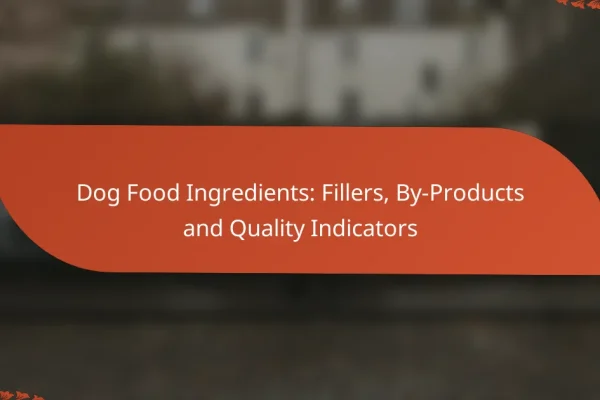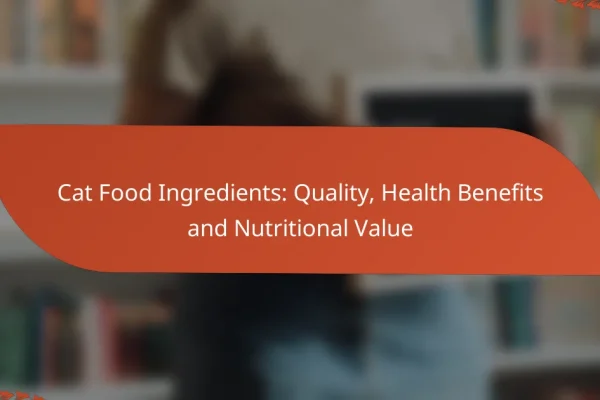What should I look for on pet food labels?
When examining pet food labels, focus on key components like the guaranteed analysis, ingredient list, and nutritional adequacy statement. These elements provide essential information about the food’s nutritional value and quality.
Guaranteed analysis
The guaranteed analysis section lists the minimum percentages of protein and fat, as well as the maximum percentages of fiber and moisture. This information helps you evaluate the nutritional content and determine if it meets your pet’s dietary needs.
For example, a dog food might have a guaranteed analysis of 25% protein and 15% fat. Ensure these values align with your pet’s specific requirements based on their age, size, and activity level.
Ingredient list
The ingredient list details what is included in the pet food, listed in descending order by weight. Look for high-quality protein sources, such as chicken or beef, at the top of the list, and avoid foods with vague terms like “meat by-products.”
Additionally, be cautious of fillers like corn or soy, which provide little nutritional value. A good rule of thumb is to choose foods with recognizable ingredients that you can easily identify.
Nutritional adequacy statement
This statement indicates whether the food meets the nutritional standards set by the Association of American Feed Control Officials (AAFCO). It may specify if the food is formulated for growth, maintenance, or all life stages.
Look for phrases like “complete and balanced” to ensure the food provides all necessary nutrients. This is crucial for your pet’s overall health and well-being.
Feeding guidelines
Feeding guidelines offer recommendations on how much food to give your pet based on their weight and life stage. These guidelines can vary significantly between brands, so always check the specific recommendations for the product you choose.
As a general practice, monitor your pet’s weight and adjust the amount of food accordingly. Overfeeding can lead to obesity, while underfeeding may result in nutritional deficiencies.
Manufacturer information
Manufacturer information includes the company name, contact details, and sometimes the location of production. This transparency is important for accountability and trust in the product’s quality.
Research the manufacturer to ensure they have a good reputation and adhere to safety standards. Look for companies that conduct regular quality checks and have a history of positive customer feedback.
How do I choose the best pet food ingredients?
To choose the best pet food ingredients, focus on high-quality proteins, whole grains, and essential vitamins and minerals. Look for products with clear labeling and avoid those with excessive fillers or artificial additives.
High-quality protein sources
High-quality protein sources are crucial for your pet’s health, providing essential amino acids for growth and maintenance. Look for named meat sources like chicken, beef, or fish at the top of the ingredient list. Avoid vague terms like “meat by-products” or “animal meal,” as these can indicate lower quality.
Consider the protein content in the food; a good range is around 20-30% for dogs and 30-40% for cats. Always check if the protein is sourced from whole meats rather than meat meals, as whole meats contain more moisture and nutrients.
Whole grains vs. fillers
Whole grains, such as brown rice or oats, provide digestible carbohydrates and fiber, which are beneficial for your pet’s digestive health. In contrast, fillers like corn and soy often lack nutritional value and can lead to allergies or digestive issues.
When evaluating pet food, aim for a product that lists whole grains as primary ingredients. If grains are not suitable for your pet, consider grain-free options that use alternative carbohydrates like sweet potatoes or peas.
Essential vitamins and minerals
Essential vitamins and minerals are vital for your pet’s overall health, supporting immune function, bone health, and energy metabolism. Look for foods that include a balanced mix of these nutrients, often listed as added vitamins and minerals on the label.
Commonly included vitamins include A, D, E, and B-complex, while minerals like calcium, phosphorus, and zinc are important for various bodily functions. Ensure the pet food meets AAFCO (Association of American Feed Control Officials) standards for complete and balanced nutrition.
What are common pet food ingredients to avoid?
Common pet food ingredients to avoid include artificial preservatives, by-products, and excessive fillers. These components can negatively impact your pet’s health and overall well-being.
Artificial preservatives
Artificial preservatives are synthetic compounds added to pet food to extend shelf life. Common examples include BHA, BHT, and ethoxyquin, which may pose health risks over time. Opt for pet foods that use natural preservatives like vitamin E (mixed tocopherols) or vitamin C instead.
When reading labels, look for phrases like “no artificial preservatives” to ensure you are choosing safer options for your pet. Avoiding these ingredients can help reduce the risk of allergies and other health issues.
By-products
By-products are secondary products derived from the processing of animal carcasses, such as feathers, hooves, or organs. While some by-products can be nutritious, many are low-quality and lack essential nutrients. It’s best to choose pet foods that specify “meat” or “meat meal” as the primary ingredient instead of vague terms like “meat by-products.”
Understanding the source of protein in your pet’s food is crucial. High-quality pet foods will clearly list the type of meat used, ensuring your pet receives the necessary nutrients for a balanced diet.
Excessive fillers
Excessive fillers are ingredients that provide little nutritional value, such as corn, wheat, and soy. These fillers are often used to bulk up pet food and reduce production costs, but they can lead to digestive issues and allergies in pets. Look for foods with high meat content and minimal fillers to ensure a healthier diet.
When selecting pet food, check the ingredient list for high-quality protein sources and limit those with fillers to ensure your pet gets the nutrients they need without unnecessary additives. Aim for products that list whole ingredients and avoid those with multiple fillers in the top five ingredients.
How can I understand pet food labeling regulations?
Understanding pet food labeling regulations involves familiarizing yourself with guidelines set by organizations like AAFCO, which ensure that labels provide accurate and helpful information. These regulations help consumers make informed choices about the nutritional quality and safety of pet food products.
AAFCO guidelines
The Association of American Feed Control Officials (AAFCO) establishes guidelines for pet food labeling to promote transparency and safety. These guidelines cover aspects such as ingredient definitions, nutritional adequacy statements, and feeding directions, ensuring that pet food manufacturers provide clear and truthful information.
For example, AAFCO requires that any claims about a product’s nutritional value must be substantiated through feeding trials or formulated to meet specific nutrient profiles. This helps pet owners choose foods that meet their pets’ dietary needs.
Labeling requirements
Pet food labels must include specific information to comply with regulations. Key elements include the product name, net weight, guaranteed analysis, ingredient list, and nutritional adequacy statement. These components help consumers understand what they are feeding their pets.
When reading a label, pay attention to the ingredient list, which is typically ordered by weight. Ingredients like meat should be listed first, indicating a higher quality product. Additionally, look for AAFCO statements that confirm the food meets established nutritional standards.
What are the benefits of choosing organic pet food?
Choosing organic pet food offers several advantages, including improved health for your pet and a reduced environmental impact. Organic ingredients are often free from synthetic chemicals and pesticides, which can lead to better overall well-being for your furry companion.
No synthetic additives
Organic pet food is typically free from synthetic additives, such as artificial colors, flavors, and preservatives. This means your pet consumes fewer chemicals that could potentially cause health issues over time. Instead, organic options rely on natural ingredients that are less likely to trigger allergies or digestive problems.
When selecting organic pet food, look for labels that specify “100% organic” or “organic” to ensure the absence of synthetic substances. Familiarize yourself with common synthetic additives to avoid, such as BHA, BHT, and ethoxyquin, which are often found in non-organic products.
Higher animal welfare standards
Organic pet food often adheres to higher animal welfare standards, ensuring that the animals used for meat and dairy products are raised in humane conditions. This includes access to outdoor spaces, organic feed, and no use of antibiotics or growth hormones. Such practices contribute to healthier animals and better-quality ingredients.
When choosing organic pet food, consider brands that are certified by recognized organizations, as they are more likely to meet stringent welfare criteria. Researching the sourcing practices of these brands can provide insight into their commitment to animal welfare and environmental sustainability.

